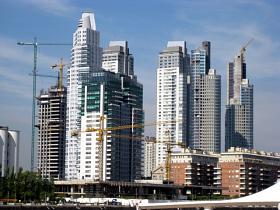Argentina: Buenos Aires presents cosmopolitan charm
Buenos Aires sprawls along the banks of the muddy La Plata river, stretches inland in new developments, and is often grey and gloomy. It is a huge city composed of neighbourhoods, or barrios. The older ones surrounding the city centre are the most famous ones: the barrios which attract tourism. Apart from the colourful tin buildings of the La Boca barrio and the famed pink tones of the Casa Rosada the presidential palace, the city is mostly monochromatic. Check out this city map of
What then is the allure?
For one thing, it is the main entry and exit point for Argentina, so getting there is simple. Check flights from your area. You can also browse for hotels and car rentals.
Buenos Aires is a city with deep anchors to the past and the ethnic and cultural heritages of its residents, but it is also the center of business, government and progressive development.
The people of Buenos Aires who refer to themselves as porteños, or port people, relish their ties to Europe, flaunt their creative energy, delight in culture, fashion and food and share a traditional melancholy for things past.
Buenos Aires was founded in 1536 when Pedro de Mendoza established a settlement on the bluffs above the river but native resistance forced the Spaniards out for nearly fifty years. They came back and tried again. It was slow going particularly under the restrictions of the Spanish crown regarding trade but the growing number of criollo residents persisted. They established trade with other South American and European countries creating traditions still in force today. Argentina proclaimed its Independence from Spain in 1816 and encouraged immigration from Europe.
The emigrants settled mostly in Buenos Aires bringing with them their culture and customs. These influences were slow to reach the provinces where landowners retained their older more conservative way of life. By 1900, following the beef boom of the 1880's, Buenos Aires was South America's largest city with a million or more European residents.
The city flourished. Buildings went up, each more splendid than the last, most in the favoured French mode. Tremendously wealthy beef barons sent their sons to Europe. They arranged profitable and beneficial marriages for their daughters. Buenos Aires became a city of culture and fashion, the arbiter of the Americas.
The city declined in a slow, gradual process that left residents confused and lamenting their lost grandeur. Labour problems and strikes suppressed by the military set a precedent for the coming years. In the 1930's, a modernization program tore down colonial buildings which had survived the turn of the century building boom to make the major avenues of Corrientes, Santa Fe and Córdoba. After World War II, the city absorbed outlying suburbs and continued to grow.
Today Buenos Aires is vast, yet easily accessible by subway or Subte. The portions of most interest to visitors surround the compact central area around the Avenida 9 de Julio, the widest avenue in the world, which runs from Plaza Constitución to Avenida del Libertador and the exclusive northern suburbs. Intersecting the Avenida 9 de Julio, the Avenida de Mayo runs west from the Casa Rosada at Plaza de Mayo to the congressional buildings at Plaza del Congreso. Street names change at Avenida de Mayo. On the northeastern corner the Retiro train station, the bus terminal and a number of airline terminals are conveniently grouped.
Corrientes crosses 9 de Julio at the Obelisk, a central landmark. There is a pedestrian tunnel beneath the street. Shopping is most fashionable on upscale Avenida Santa Fe and the Florida and Lavalle pedestrian malls.
The charm of Buenos Aires for many visitors lies in the neighbourhoods known as barrios. There are many tourists never sees unless they go out from the center into the newer suburbs but the most famous ones surround the center of the city and have their roots in the city's history.
About the writer:
Bonnie Hamre writes with About.comComments
There are 0 comments on this post















